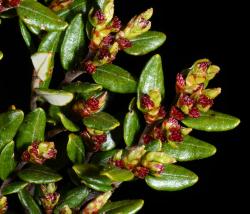- ≡ Nothofagus subgen. Fuscospora R.S.Hill & J.Read, Bot. J. Linn. Soc. 105: 69 (1991)
- = Nothofagus sect. Planae Steenis, Blumea 7: 306 (1952) nom. illeg.
- = Nothofagus sect. Sempervirentes subsect. Quadripartitae Steenis, Blumea 7: 146 (1952)
- = Nothofagus sect. Sempervirentes Steenis, Blumea 7: 146 (1952)
- = Nothofagus subgen. Nothofagus sect. Calusparassus subsect. Quadripartitae (Steenis) Steenis, J. Arnold Arbor. 34: 337 (1953)
- = Nothofagus subgen. Nothofagus sect. Calusparassus subsect. Tripartitae Steenis, J. Arnold Arbor. 34: 338 (1953)
- = Pleiosyngyne Baum.-Bod., Syst. Fl. Neu-Caledonien 86 (1992) nom. inval.
- = Nothofagus sect. Calucechinus subsect. Saccofagus Baum.-Bod., Syst. Fl. Neu-Caledonien 93 (1992)
Evergreen trees or shrubs up to 40 m high. Stipules peltate or non-peltate. Leaves distichous, lamina margins entire or 1-serrate; fimbrial vein incomplete; with or without large globular glandular trichomes on cuticle; with solitary unicellular trichome type A with a very small, unthickened base and with a large, unicellular, thin-walled trichome emerging; without solitary unicellular trichome type C. Stomata randomly oriented; without thickened T-pieces of cuticle at the poles separating the two guard cells; without giant stomata over the major veins; stomata size within the areoles variable. Upper epidermal cells over veins more elongate than areolar cells, with granular cell walls. Male dichasium 1–3-flowered; flowers campanulate, lobes prominent or weak, symmetric or asymmetric; stamens <20, centripetal development; anthers slightly curved, distal connective protrusion weakly developed, filament connective free, without epidermal papillae. Female dichasium with 1 central dimerous flower and 2 lateral trimerous flowers, or 1 dimerous flower and 1 trimerous flower; stigmas clavate and weakly decurrent. Cupule valves 2–4; outer surface of valves with simple trichomes; lamellae membranous becoming scarious, 1–3 rows/valve, margin entire becoming erose; nuts triquetrous or lenticular, often twisted, 3- or 2-winged.
Pollen: Peritreme, mesocolpia straight to convex; colpi short, spatulate or parallel-sided, with U-shaped ends, margins inwardly conspicuously heavily thickened, aperture 4–11 µm long, polar to equatorial lengths ratio = 0.3.
| 1 | Lamina margins entire, smooth | 2 |
| Lamina margins toothed | 3 | |
| 2 | Lamina ovate to triangular-ovate, often undulate, tapered obliquely to base | cliffortioides |
| Lamina oblong-elliptic to ovate, usually planar, tapered evenly to base | solandri | |
| 3 | Lamina teeth sharp, apiculate, tapered obliquely to base; domatia present in the axils of the midrib and lower secondary veins on the abaxial side of the lamina | fusca |
| Lamina teeth blunt, not apiculate, tapered equally to base; domatia absent from the axils of the midrib and lower secondary veins on the abaxial side of the lamina | truncata |
A genus of six species in Australia, New Zealand and Chile. Fuscospora is represented by one endemic species in each of Australia and Chile, and four endemic species in New Zealand.
| Category | Number |
|---|---|
| Indigenous (Endemic) | 4 |
| Total | 4 |
In New Zealand hybrids have been documented between all species of Fuscopora the most common being that between F. cliffortioides and F. solandri. There are three formally named hybrids:
Fuscospora ×apiculata (Colenso) Heenan & Smissen
Hybrid parentage: Fuscospora solandri (Hook.f.) Heenan & Smissen × F. truncata (Colenso) Heenan & Smissen (Cockayne & Allan 1934).
Fuscospora ×blairii (Kirk) Heenan & Smissen
Hybrid parentage: Fuscospora fusca (Hook.f.) Heenan & Smissen × F. cliffortioides (Hook.f.) Heenan & Smissen (Cockayne & Allan 1934).
Fuscospora ×dubia (Kirk) Heenan & Smissen
Hybrid parentage: Fuscospora solandri (Hook.f.) Heenan & Smissen × F. fusca (Hook.f.) Heenan & Smissen. (Cockayne & Atkinson 1926; Allan 1929).




